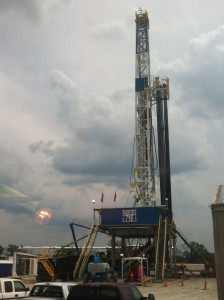Onshore-tested MHA drilling fluid seeks offshore applications
By Katherine Scott, associate editor

As regulations around handling and disposal of drilling fluids get tougher around the world, ViChem Specialty Products believes its multi-hydroxyl alcohol (MHA) drilling fluid system can fill a niche need. The fluid, which was launched in 2011, is a “hybrid between OBMs and WBMs,” Dr Buddy Gaertner, ViChem director of research and development, said. The multi-hydroxl alcohols in the system are short-chain hydrocarbons similar to oil, allowing for performance and stability comparable to oil-based muds. However, unlike petroleum products, the MHA molecule contains hydroxyl groups on each of the carbons in the chain, allowing it to be soluble in water and remain non-toxic to the environment.
So far, the MHA has been field-tested and commercially deployed onshore only, primarily in the US Marcellus and Eagle Ford plays, but ViChem is working to take the fluid system offshore for additional field testing. The company notes that lab tests have shown its L-20 lubricant, which is a non-petroleum based organic vegetable oil, will work well with the seawater used in offshore drilling. “It turns out that our lubricant is more effective in saltwater and helps it work well with multi-hydroxyl alcohols,” Dr Gaertner said.
The best application for the MHA system, he continued, is in areas where environmental drivers are strongest, such as Pennsylvania, West Virginia, Colorado and New York. “We’re working with an environmental consulting agency, Tox Strategies, on our overall strategy to quantify environmental claims and will submit our product to several companies to be tested for offshore use in the Gulf of Mexico but also to expand that to make sure that we meet North Sea regulations, as well.”

In a December 2011 field trial in the Eagle Ford/Woodbine, the MHA system was used to compare the toal depth versus days in the surface-hole sections of two horizontal wells, one using the MHA and one using a conventional WBM. The MHA system drilled without incident to 13,500 ft in less than 18 days, while the offset well drilled with the conventional WBM took 29 days to reach 10,800 ft and routinely pulled tight, taking reaming upon completion to run the final string of casing. The MHA system not only saved time but also increased the production potential of the well because of the additional length of the horizontal in the payzone, according to ViChem.
The MHA system does have its limitations, particularly around cost and temperatures. “For your conventional water-based muds, where you’re operating in very shallow, easy wells, there’s still a target for it because they are very inexpensive. And because our system is natural, there’s a temperature limit of about 350°F, so in those places that are really deep and really hot, OBMs are still needed,” he said.
Dr Gaertner attributes the success of the MHA system so far to the three years of research that was done at ViChem’s Conroe, Texas, lab before it was rolled out. “That’s why we were able to take this giant leap from what has been traditionally used in the oilfield and what we’re proposing to use right now, because we started in a laboratory, backed it up with research and then combined that with field application.”




